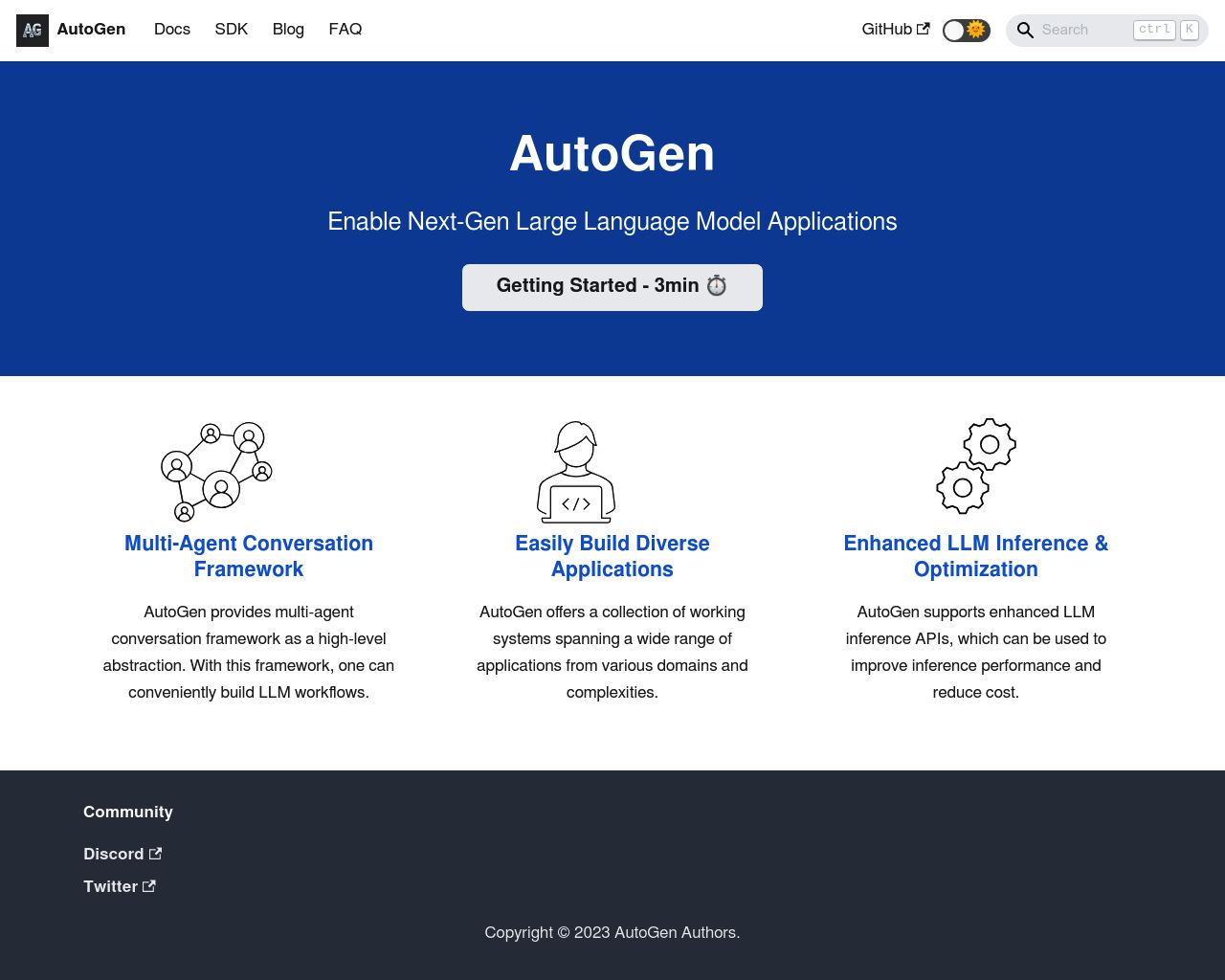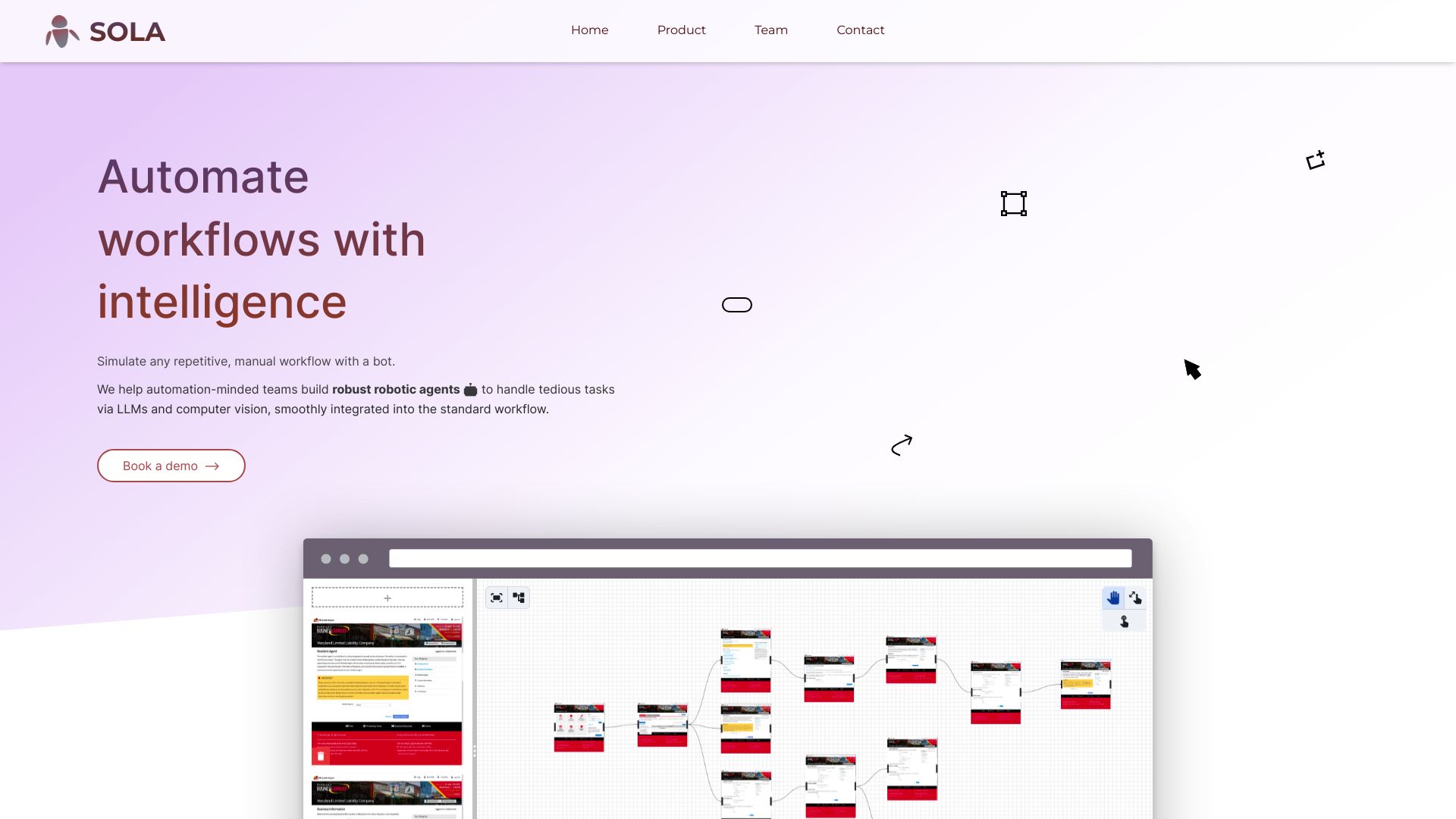AutoGen vs. Sola: AI Automation Tools Compared
AI-powered automation tools revolutionize workflow efficiency, but choosing the right platform can be challenging. This comparison of AutoGen, Sola, and SmythOS explores their features, capabilities, and use cases. AutoGen excels in orchestrating multi-agent conversations for complex problem-solving. Sola simplifies workflow automation through intuitive bot creation. SmythOS combines these strengths with enhanced security and a user-friendly interface. Whether you’re a developer seeking advanced AI frameworks, a business leader looking to streamline operations, or a non-technical professional exploring automation, this analysis will help you make an informed decision about the best AI solution for your needs.
AutoGen Overview
AutoGen empowers developers to create sophisticated Large Language Model (LLM) applications through multi-agent conversations. The framework orchestrates customizable agents that interact with each other, LLMs, tools, and humans to tackle complex tasks.


AutoGen’s core functionality revolves around facilitating conversations between multiple AI agents. These agents collaborate autonomously or with human input to solve diverse problems. The framework maximizes LLM performance through enhanced inference capabilities, including tuning, caching, error handling, and templating. This optimization proves crucial when working with resource-intensive models like GPT-4.
AutoGen empowers developers to create sophisticated Large Language Model (LLM) applications through multi-agent conversations.
Developers can tailor AutoGen’s agents to specific task requirements, integrating LLMs, human inputs, and various tools. The framework supports both fully autonomous operations and human-in-the-loop problem-solving, offering flexibility for applications where human oversight is essential. AutoGen has demonstrated effectiveness across a wide range of use cases, from automated task solving and code generation to complex problem-solving in group chat scenarios.
For debugging and optimization, AutoGen provides logging tools for API calls, enabling developers to diagnose and refine LLM-based systems effectively. The framework also includes EcoOptiGen, a cost-effective technique for tuning large language models, underscoring its focus on enhancing LLM efficiency and effectiveness.
AutoGen has demonstrated effectiveness across a wide range of use cases, from automated task solving and code generation to complex problem-solving in group chat scenarios.
While AutoGen offers powerful capabilities for LLM-driven applications, it requires coding expertise to set up agents and workflows. The lack of a visual builder or no-code editor may present a barrier for non-technical users seeking to leverage its features. Additionally, the framework’s documentation does not explicitly mention certain enterprise-focused features like data encryption or IP control, which may be considerations for some organizations.
Sola Overview
Sola empowers businesses to streamline workflows through AI-powered automation. This open-source platform enables users to create intelligent bots capable of handling repetitive tasks across various industries.


Sola’s core features include a Workflow Recorder that captures on-screen processes, an Annotation Editor for labeling workflow steps, and a Bot Builder that converts annotated workflows into AI-powered bots. The platform integrates seamlessly with major browsers and desktop applications, allowing for versatile automation across different software environments.
Sola’s core features include a Workflow Recorder that captures on-screen processes, an Annotation Editor for labeling workflow steps, and a Bot Builder that converts annotated workflows into AI-powered bots.
Users can create bots from screen recordings in minutes, making Sola accessible to those without extensive programming knowledge. The platform’s adaptive learning capabilities enable bots to improve over time, incorporating new logic automatically. This flexibility proves valuable across sectors such as legal, finance, insurance, and healthcare, where tasks like data entry, document processing, and compliance reporting benefit from automation.
While Sola offers significant advantages in workflow automation, it lacks some advanced features found in other AI agent builders. The platform does not provide a dedicated visual builder or no-code editor, which may limit accessibility for non-technical users. Additionally, Sola does not offer specific features like constrained alignment or a hosted vector database, which could be important for certain enterprise-level applications.
Sola’s vision centers on making workflow automation accessible and efficient, allowing companies to focus on high-value tasks. The platform provides email and chat support during business hours, along with onboarding training and implementation services. For businesses seeking to extend functionality, Sola offers developer APIs and can develop custom solutions upon request.
Feature Comparison
AutoGen and Sola offer contrasting approaches to AI agent development, with notable feature gaps in core components and security. AutoGen provides a flexible framework for creating multi-agent systems that can collaborate autonomously or with human input. Its strength lies in orchestrating complex conversations between AI agents to solve diverse problems. Sola, on the other hand, focuses on streamlining workflow automation through AI-powered bots that can handle repetitive tasks across various industries.
In terms of core components, AutoGen lacks a visual builder and no-code editor, requiring coding expertise to set up agents and workflows. This contrasts with Sola’s Workflow Recorder and Annotation Editor, which allow users to create bots from screen recordings without extensive programming knowledge. However, AutoGen offers more advanced features for multi-agent collaboration and problem-solving, while Sola emphasizes ease of use for business process automation.
Regarding security features, both platforms have gaps. AutoGen’s documentation does not explicitly mention data encryption or IP control, which may be crucial for enterprise-level deployments. Sola also lacks detailed information on these security aspects. Neither platform specifically addresses constrained alignment, which is essential for ensuring AI behavior aligns with organizational goals and ethical guidelines. These security gaps highlight areas where both AutoGen and Sola could improve to meet the stringent requirements of enterprise users and sensitive applications.
Feature Comparison Table
| AutoGen | Sola | SmythOS | |
|---|---|---|---|
| CORE FEATURES | |||
| Hosted Agents (Dev, Production) | ✅ | ❌ | ✅ |
| Visual Builder | ❌ | ✅ | ✅ |
| No-Code Options | ❌ | ✅ | ✅ |
| Debug Tools | ✅ | ❌ | ✅ |
| Multimodal | ✅ | ❌ | ✅ |
| Multi-Agent Collaboration | ✅ | ❌ | ✅ |
| Work as Team | ✅ | ❌ | ✅ |
| Agent Work Scheduler | ❌ | ✅ | ✅ |
| SECURITY | |||
| Constrained Alignment | ❌ | ❌ | ✅ |
| IP Control | ❌ | ❌ | ✅ |
| COMPONENTS | |||
| Huggingface AIs | ✅ | ❌ | ✅ |
| Zapier APIs | ✅ | ❌ | ✅ |
| Classifiers | ✅ | ❌ | ✅ |
| Data Lakes | ❌ | ❌ | ✅ |
| DEPLOYMENT OPTIONS (EMBODIMENTS) | |||
| Staging Domains | ❌ | ❌ | ✅ |
| Production Domains | ❌ | ❌ | ✅ |
| Deploy as Scheduled Agent | ❌ | ✅ | ✅ |
| Deploy as GPT | ✅ | ❌ | ✅ |
| DATA LAKE SUPPORT | |||
| Hosted Vector Database | ❌ | ❌ | ✅ |
| Sitemap Crawler | ❌ | ❌ | ✅ |
| YouTube Transcript Crawler | ❌ | ❌ | ✅ |
Conclusion
AutoGen, Sola, and SmythOS each offer unique approaches to AI agent development and workflow automation. AutoGen excels in orchestrating complex multi-agent conversations, while Sola focuses on streamlining business processes through intuitive bot creation. However, SmythOS emerges as the superior choice, combining the strengths of both platforms while addressing their limitations.
SmythOS stands out with its comprehensive feature set, including a visual builder, no-code editor, and support for multimodal interactions. These tools make AI agent creation accessible to both technical and non-technical users. Unlike AutoGen and Sola, SmythOS offers robust security measures, including data encryption and IP control, crucial for enterprise-level deployments.
The platform’s versatility shines through its extensive integration ecosystem, supporting over 300,000 integrations and various AI models. This flexibility, combined with SmythOS’s ’Create Once, Deploy Anywhere’ approach, enables businesses to seamlessly incorporate AI agents into existing workflows across multiple platforms.
For those ready to experience the future of AI automation, create a free SmythOS account today. With unlimited agents, a 30-day money-back guarantee, and the ability to deploy AI agents anywhere, SmythOS offers a risk-free opportunity to revolutionize your workflow. Explore our diverse range of AI-powered agent templates to jumpstart your journey into intelligent automation and unlock the full potential of AI for your business.
Last updated:
Disclaimer: The information presented in this article is for general informational purposes only and is provided as is. While we strive to keep the content up-to-date and accurate, we make no representations or warranties of any kind, express or implied, about the completeness, accuracy, reliability, suitability, or availability of the information contained in this article.
Any reliance you place on such information is strictly at your own risk. We reserve the right to make additions, deletions, or modifications to the contents of this article at any time without prior notice.
In no event will we be liable for any loss or damage including without limitation, indirect or consequential loss or damage, or any loss or damage whatsoever arising from loss of data, profits, or any other loss not specified herein arising out of, or in connection with, the use of this article.
Despite our best efforts, this article may contain oversights, errors, or omissions. If you notice any inaccuracies or have concerns about the content, please report them through our content feedback form. Your input helps us maintain the quality and reliability of our information.
